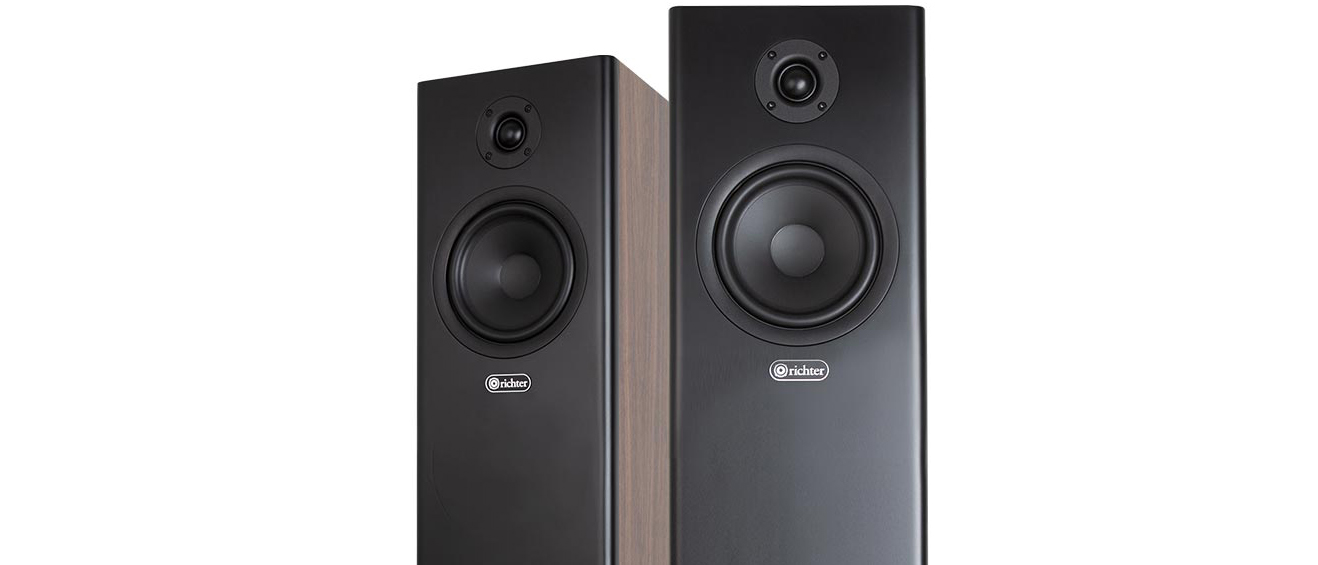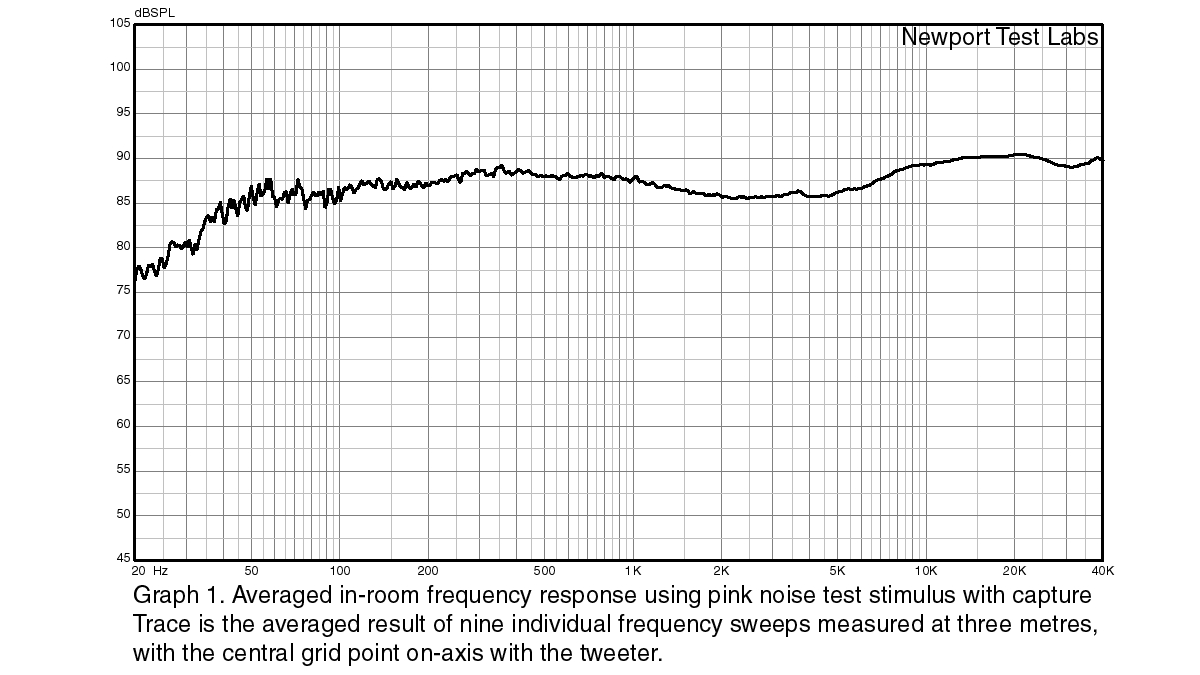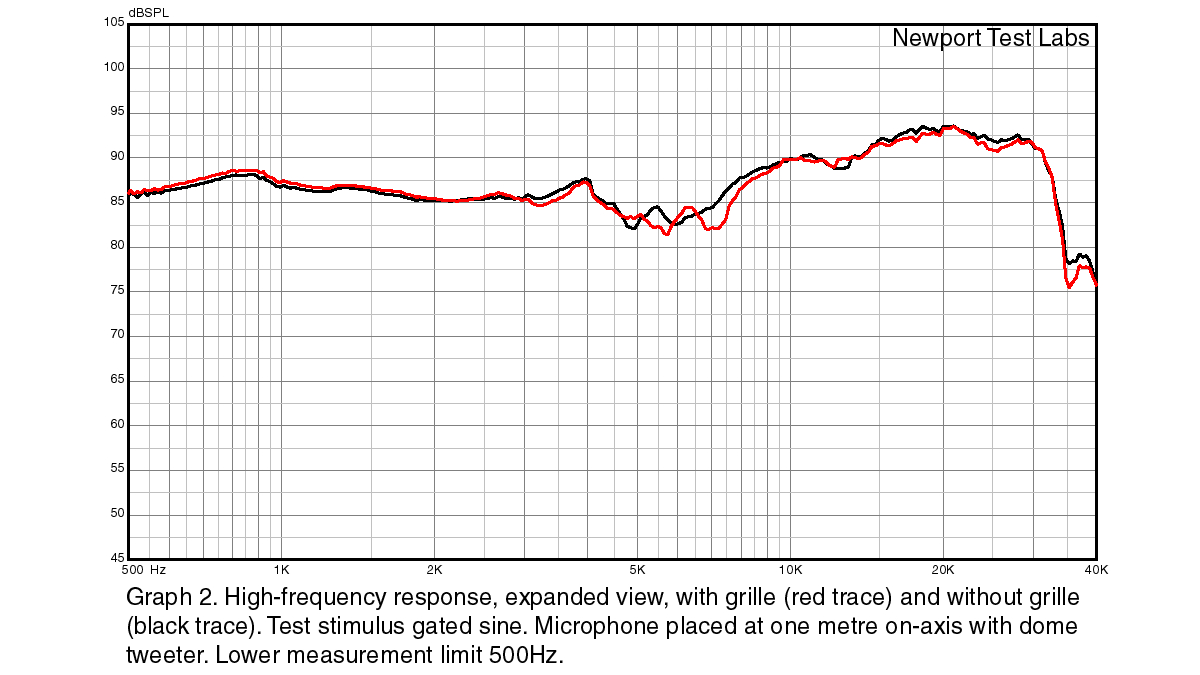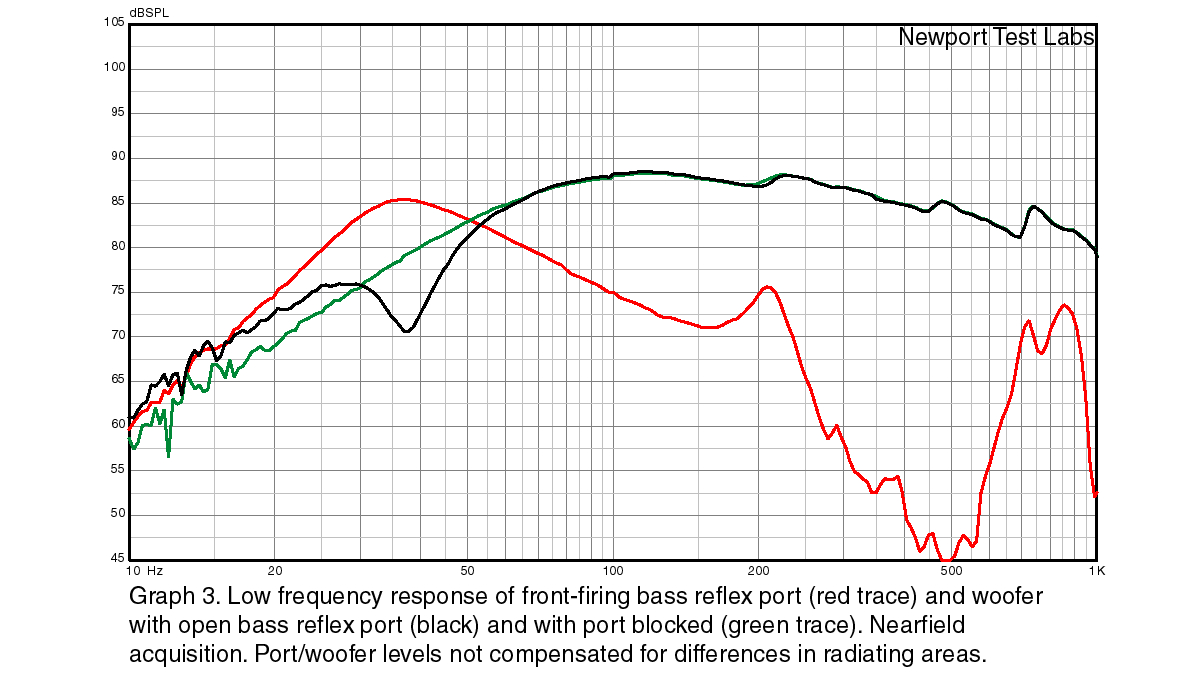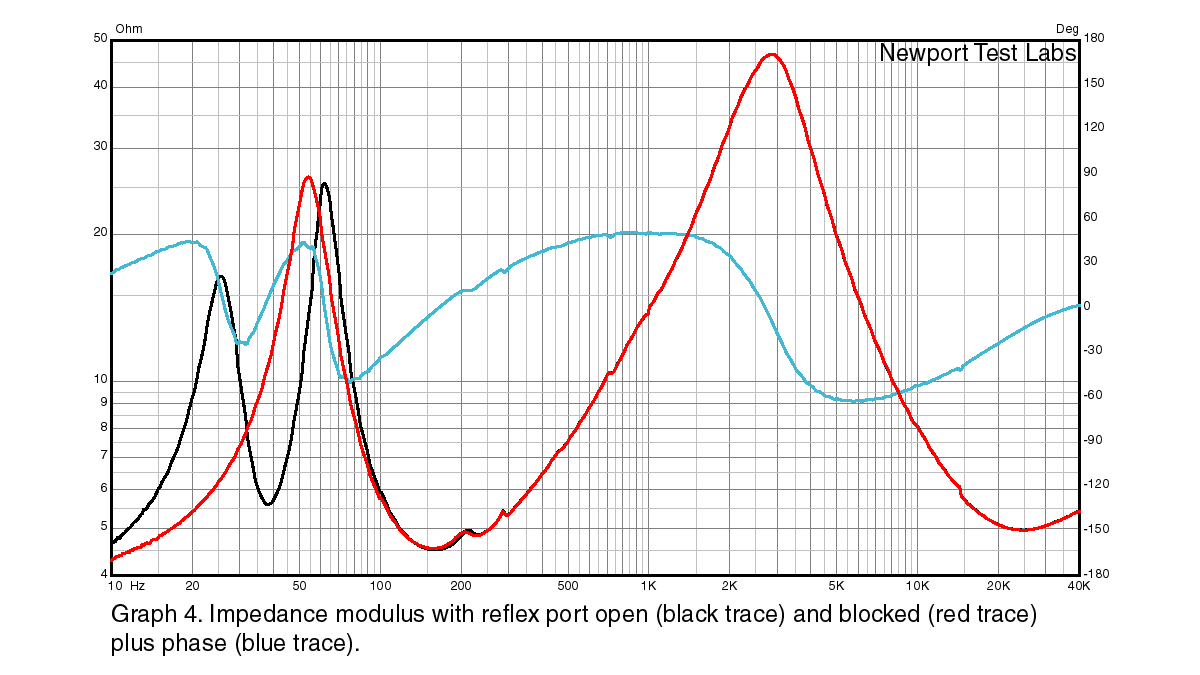Sound+Image Verdict
For the price, the Richter Harlequin S6 are exceptional floorstanding speakers, with gorgeous sound, design, power and efficiency. Plus, they're Australian-made to boot.
Pros
- +
Top-shelf sound
- +
Outstanding value
- +
Beautiful finishes
Cons
- -
No biwiring or biamping
Why you can trust What Hi-Fi?

This review originally appeared in Sound+Image magazine, one of What Hi-Fi?’s Australian sister publications. Click here for more information on Sound+Image, including digital editions and details on how you can subscribe.
Richter can lay claim to being one of Australia’s oldest loudspeaker manufacturers, and the Harlequin one of its longest-running designs. The Harlequin name derives from the mischievous ‘devil’ or ‘demon’ character in French passion plays of the 16th century, though it is better recognised today with the chequered costume developed during Italy’s subsequent commedia dell’arte.
The name fits well among Richter’s mystic speakers – the Wizards, the Merlins, and the outlying Thor, this last chosen for the presumably ‘thunderous’ subwoofer of the latest Series 6 line-up.
Equipment
The Harlequin is an unusual design – a two-way, two-driver floorstanding loudspeaker. That’s unusual because most two-way designs are in small cabinets that are intended to be placed on stands or on a shelf or side-table (and indeed Richter has just such a model in its range: the Merlin).
Yet floorstanding two-way speakers have many advantages over their smaller counterparts. Foremost among these is that the larger cabinet enables a more extended bass response than otherwise possible, because any given bass driver will always deliver more bass in a large enclosure than the same driver in a smaller one.
An important but less immediately obvious advantage of a floorstanding two-way design is that it means there’s no need to buy a pair of stands, as there obviously is with a stand-mount design. And lest you under-estimate the importance of this, we suggest you investigate the current retail price of a decent pair of loudspeaker stands!
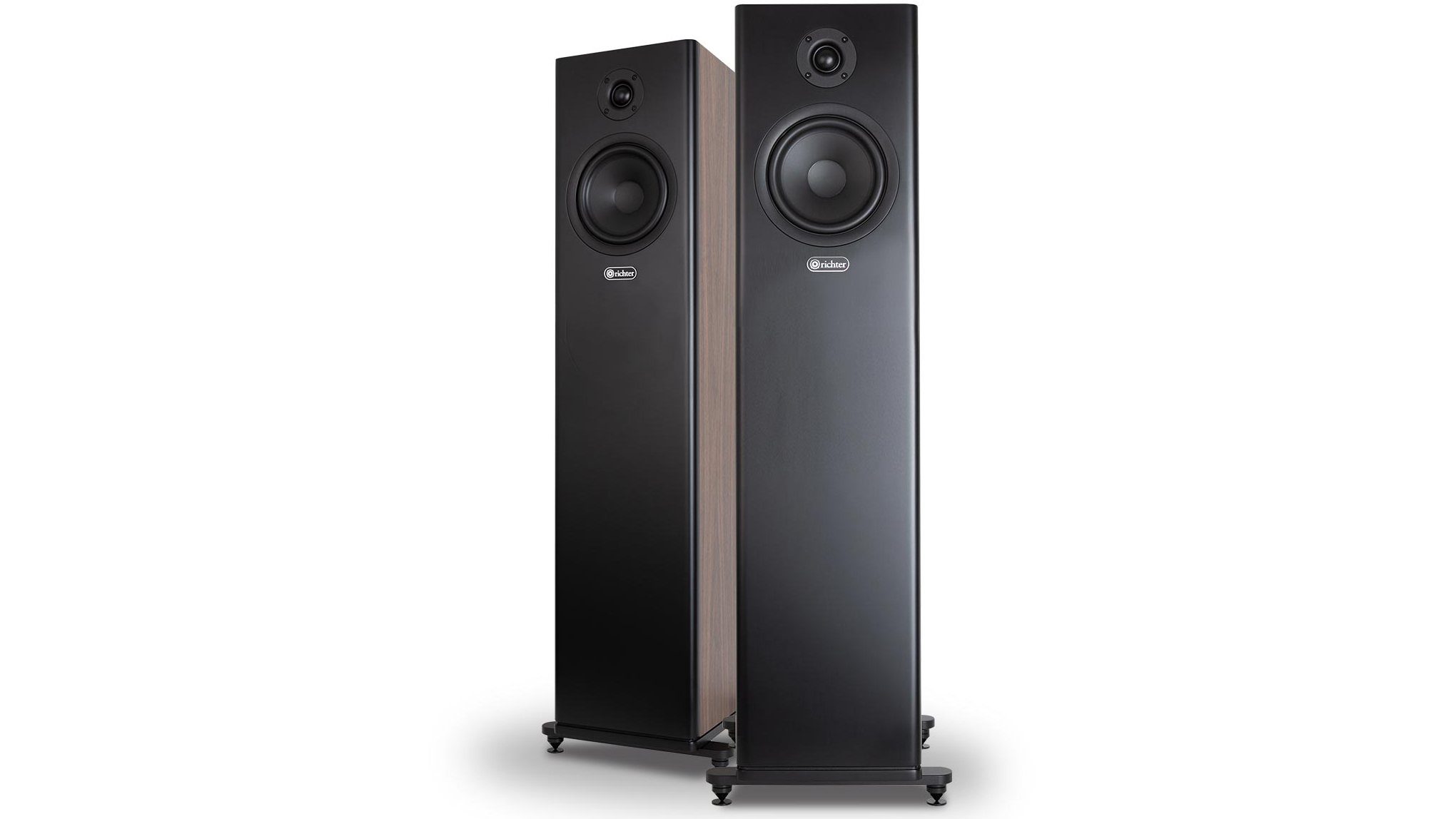
There’s also the look. It may just be us, but we think a floorstanding loudspeaker looks better in a typical lounge-room than a pair of small speakers on stands.
The 165mm bass/midrange driver in the Harlequin S6 is new for the ‘Legend Series 6’ of which it is part, also used in the larger Wizard S6, which has two of them in each cabinet. It’s a brand-new driver for Richter, designed by Dr Martin Gosnell. Although the driver is 165mm, the Thiele/Small diameter is 128mm, which gives an effective cone area (Sd) of 129cm, which is slightly greater than that of the previous model Harlequin.
The latest hi-fi, home cinema and tech news, reviews, buying advice and deals, direct to your inbox.
Although the cone looks like polypropylene, looks can be deceiving, because it’s actually made from a mixture of paper, hemp, kapok and wool. The blackness and gloss of the cone’s surface is due to a sealant coating which ensures that the cone is not hygro-scopic, so its performance will be uniform irrespective of humidity.
We must say that Richter has really tidied up the look of this driver, which is not only recessed into the front baffle but also has the periphery of its chassis neatly covered by a black rubber dress ring, so you can’t see any of the bolts that secure it to the cabinet. As with other Series 6 models, this is the result of research by Richter which revealed, among other things, that many Australians like to use speakers without grilles, but don’t like looking at ugly bolts when they do so.
The tweeter is also a brand-new design for Richter, using a high-power neodymium magnet to drive the 25mm soft-fabric dome. Says Dr Gosnell: “it has lower distortion than the tweeter we previously used in the Harlequin, and also has a lower resonant frequency that gives us the desired phase characteristics and a frequency response that extends to beyond 30kHz.”
We should note that because it’s expensive for small loudspeaker manufacturers to design their own drivers and have them built, this self-same tweeter is also used in the Wizard and the Merlin models.
The new drivers meant that the Harlequin’s crossover network was also re-designed, during which process Richter took the opportunity to upgrade the various components on the PCB, so this ‘S6’ version has high-quality acoustic polypropylene bipolar capacitors, high-power cermet wire-wound resistors, and both with air-cored and ferrite-cored inductors, with the former and latter cross-mounted to eliminate magnetic interaction.
The Harlequin is a bass-reflex design, with the port at the rear of the cabinet, for which Richter provides foam plugs that can be optionally used, as the company says in its brochure, “for even greater control of room and equipment variables”. Although many manufacturers now supply ‘bungs’ that can be used to tune the bass response, those on the Harlequin work better than most when they are inserted, because of the greater volume of air inside the cabinet.
Just below the bass reflex port is a single pair of very high-quality gold-plated speaker terminals, both colour-coded and clearly marked with ‘+’ and ‘–’ identifiers. These, too, are new for Richter, and they easily accommodate bare wire, pin connectors, spade connectors, ring connectors and banana plugs… the full gamut.
Also new for the Harlequin is the cabinet itself. Although the raw measurements don’t really reflect it, the cabinet’s walls are now not parallel, sloping inwards from being 221mm wide at the front to 210mm wide at the rear. This is presumably to ameliorate the creation of standing waves, but it also makes the cabinets appear less ‘boxy’ than a standard rectangular prism.
To complement this cabinet is a new ‘Matte Black’ cabinet finish that’s textured on all sides except the baffle, which has a smoother, ‘slicker’ black finish. There’s also the finish pictured in our lead image on the previous page, which Richter’s owner, Brian Rodgers, calls ‘New Walnut’, this having has a wood-grained finish.
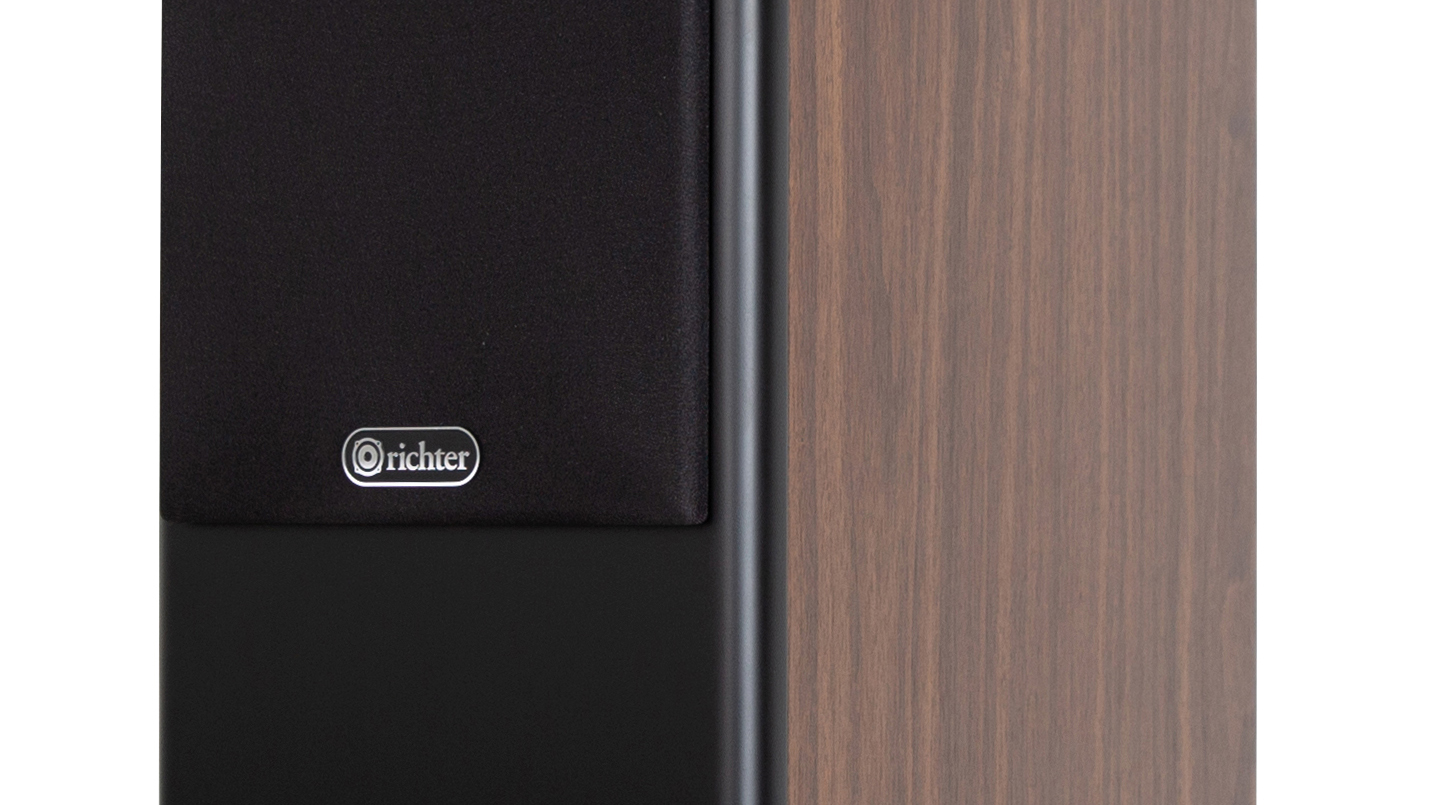
Irrespective of which finish works best for your décor, it will come with a black speaker grille that attaches magnetically, so if you choose not to use it, you won’t see any unslightly grille fixings. Richter also puts its silver/black embossed logos on both the grille and the baffle underneath, partly to ensure brand recognition, but also because again, their research showed that people do like looking at badges.
The modern trend to make floorstanding speakers tall and narrow has implications for their stability, which can be a serious issue in households with pets or small children... or both! Richter has addressed this on the Harlequin by providing a pair of almost boomerang-shaped ‘speaker stabilisers’ that it says brings their stability up to furniture-industry standards.
These stabilisers come included as standard with the Harlequin Series 6 speakers but they’re also available separately (for AU$249) because their clever design is such that they can be fitted to a wide range of floorstanding speakers made by manufacturers other than Richter.
So if you already own a pair of floorstanding speakers with a topple factor that you find alarming, we’d encourage you to see if the Richter outrigger feet will fit them. The stabilisers come with spikes, spike protectors and rubber feet.
Performance
Yes it’s a floorstander, and yes it has more bass than a standmount loudspeaker with an equivalently-sized bass/midrange driver, but size does count, so don’t expect quite the bass extension and sheer ‘thwack’ that you’d get from, say, a pair of the larger Richter Wizards.
That said, you’re going to be very pleased with the bass you will hear when you audition the Harlequins because it is tight, rhythmic, and has the type of slam and pace you’d only expect to find in a much larger and more expensive pair of speakers, plus its bass goes deeper than you’re likely to need unless you’re using them for the front channels of a home theatre system and need to hear movie sound effects. (In which case we’d suggest Richter’s Thor 6 subwoofer would be the go to augment your home cinema sound system – perhaps using Merlins for rears.)
We fired up one of our favourite bass testers, which happens to be one of our favourite disco/funk tracks as well. We’re talking Act Like You Know by Fat Larry’s Band, on the album ‘Break-Out’. (Larry really was fat too... which no doubt contributed to his death aged only 38, of a heart attack.)
This track is notable not only for Larry’s drumming, which really sizzles on this track, but for the fabulously fluid, inventive – and complex! – bass lines by Larry La Bes. If you’re a gamer you may have heard this as part of the soundtrack CD to the 2002 video game ‘Grand Theft Auto: Vice City’.
Later on, when the boogie synth line kicks in and then the horns, you’ll get to hear the Harlequins’ great midrange delivery. But while you’re waiting, listen to the depth of the skin sound on Larry’s kick drum and the ‘string’ sound of La Bes’ bass, as well as the way you can hear the attack on the bass strings distinct from the fundamental. Impressive stuff.

To listen to the midrange, we’d recommend Sarah McLaughlin’s sad but beautiful song Angel which she wrote after the death of the Smashing Pumpkins’ keyboard player Jonathan Melvoin. The Harlequins reveal McLaughlin’s fragile voice to perfection, especially when she shifts register. You’ll also hear the sympathetic way the Richters handle the rather poorly recorded piano sound.
Can the Harlequins rock? You bet they can. We fired up the Rolling Stones’ Sympathy for the Devil and cranked the volume as high as we dared. We love the sonic complexities of this song, the samba rhythm, the lyrics, the slow burn that climaxes with arguably the most significant lead break Keef’s ever played.
The scream of his guitar leapt from the Harlequins like a banshee, so clean yet so raw we were surprised even though we knew exactly when to expect it. The Richters delivered the totality of the sound-field from the mix and all the instruments with accuracy and precision throughout the entire track.
We found the Harlequins’ highest frequencies a little forward in the mix, but also found that by leaving the grilles on and turning the speakers so that our listening position was a little off-axis, we easily reduced the highs and achieved our preferred sonic balance.
We think being able to tune the high-frequency delivery this way is a definite advantage. If a speaker has too little treble, there’s no way to fix it through positioning. But here, whatever midrange/treble balance you prefer to arrange for yourself, you will find that these Richters deliver beautifully crystalline treble that transmits the air around the highest notes.
Verdict
Richter’s Harlequins are outstandingly good speakers you should most definitely audition if you’re seeking solid sound from relatively compact floorstanders, and of course you have the additional pleasure of buying Australian-designed speakers.
We liked everything about them: sound quality, appearance, power-handling ability, and efficiency. We most particularly liked the price.
Lab test report
Newport Test Labs measured the in-room averaged frequency response of the Richter Harlequin S6 speakers using pink noise as this is the test method that most closely simulates the response that would be perceived by the human ear. The result, shown in Graph 1, below, is obviously excellent, with very good low- and high-frequency extension.
Graph 1 shows that the low-frequency response is 3dB down at38Hz, which means that it's probably exactly what Richter would have measured, except that Richter's specification of 31Hz is the speaker's–6dB down point.
The room in which the speakers are used, and the speakers' proximity to boundaries (walls, etc) will have a significant effect on the low-frequency extension, and in all cases will give greater extension than the one measured (and graphed) by Newport Test Labs. However, to put things into a musical perspective, 31Hz (D₁) is just three semitones below 38Hz (B₀) on the tempered scale, so it's a tiny difference in extension.
Although frequency extension is important, it's also important that a loudspeaker exhibits linearity across the midrange, in particular, as well as a neutral spectral skew. As you can see from Graph 1, the Richter Harlequin S6 excels in both areas with the midrange linearity from about 100Hz up to 1.5kHz being within ±1.5dB and there's a completely neutral spectral skew.
As you can see on the graph the S6's frequency response is not completely flat, with a mild (–2.5dB) but broad dip that starts a bit above 1kHz and runs up to 8kHz. Above this frequency the response continues to rise before peaking at around +2.6dB at 20kHz, after which there's a roll-off to 30kHz.
Although the high-frequency response appears to rise above 30kHz, this is in fact an artefact of the measurement technique which 'averages' the levels across each third-octave. The high-frequency response actually rolls off very steeply above 30kHz, as shown in Graph 2 (and as suggested by Richter's specification for the Harlequin S6).
The Richter Harlequin S6's high-frequency response is shown in greater detail in Graph 2, above, but this time, rather than an in-room pink noise response, as in Graph 1, it's a gated sine measurement, which gives the response the speaker would return if it were measured in an anechoic chamber. This graph also shows the response measured with the grille off (black trace) and with the grille in place (red trace).
You can see that the increased resolution enabled by the gated sine measurement technique, together with the removal of third-octave averaging, clearly shows the high-frequency roll-off above 30kHz. It also shows that the broad dip shown in Graph 1 is rather more complex, with a shelf from around 2kHz up to 3kHz, followed by a peak, then a suck-out from 4.5kHz to 7kHz, after which there's a steep rise to 21kHz.
Graph 2 also shows that the Harlequin S6's frequency response is marginally smoother without the grille than with, but there's so little difference that it will be a matter of whether you prefer the look of the speakers with the grilles on or off – though of course using the grilles affords a level of physical protection for both drivers, so it would be safer to use them than not.
The low-frequency response of the Harlequin S6 design is shown in Graph 3. The black trace shows the nearfield response of the bass/midrange driver when the rear-firing bass reflex port is left open, while the green trace shows the response when the port is blocked using the bung.
As you can see, the response is identical above 60Hz, but below 60Hz the output of the driver rolls off steeply when the port is open, but shallowly when it's blocked, exactly according to theory for the two different cabinet alignments. The red trace on the graph shows the cabinet is tuned for 37Hz, so this is the frequency at which the port delivers maximum output.
Although Richter rates the nominal impedance of the Harlequin S6 as 6Ω, Graph 4 shows that it's been given this rating primarily because the minimum specified impedance is 4.6Ω, and this is exactly what Newport Test Labs measured.
Richter should probably also have specified the frequency at which it reaches the 4.6Ω minimum (it's at 160Hz) but full marks for specifying a minimum at all (since so few manufacturers do and they all should), and extra bonus points for being realistic about the nominal impedance. (You can see that the impedance actually falls below 4.5Ω below 12Hz, but impedance is usually measured – and stated – only across a 20Hz to 20kHz bandwidth.
In addition to showing the impedance of a speaker, Graph 4 also shows cabinet and other resonances and you can see very small ones at 200Hz, 280Hz, 700Hz and 14kHz.
Although the impedance falls above the crossover frequency (at around 3kHz), it's still a little above 5Ω at 20kHz and rises above 25kHz, which means amplifiers will be happy to drive them, not matter what Class the output stage might be – from Class-A right through to Class-G, but most importantly with Class-D amplifiers. Amplifiers will also be happy driving the Harlequin Series VI speakers, because the phase angles are controlled and at phase angles of 45º their impedance is always 6Ω or higher.
The Harlequin S6's fairly large cabinet means that it's more efficient than I would normally expect for a two-way design, with Newport Test Labs reporting a sensitivity of 87dBSPL at 1 metre for 2.83Veq input. Although this is an excellent result, it is a little lower than Richter's claim for 88.5dBSPL.
As for the overall frequency response of the Richter Harlequin S6, Newport Test Labs put it at 38Hz to 33kHz ±3dB.
Sound+Image is Australia's no.1 mag for audio & AV – sister magazine to Australian Hi-Fi and to the UK's What Hi-Fi?, and bestower of the annual Sound+Image Awards, which since 1989 have recognised the year's best hi-fi and home cinema products and installations. While Sound+Image lives here online as part of our group, our true nature is best revealed in the print magazines and digital issues, which curate unique collections of content each issue under the Editorship of Jez Ford, in a celebration of the joys that real hi-fi and high-quality AV can bring. Enjoy essential reviews of the most exciting new gear, features on Australia's best home cinemas, advice on how to find your sound, and our full Buying Guide based on all our current and past award-winners, all wrapped up with the latest news and editorial ponderings. Click here for more information about Sound+Image, including links to buy individual digital editions and details on how best to subscribe.
